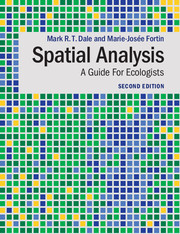Book contents
- Frontmatter
- Dedication
- Contents
- Preface
- 1 Spatial concepts and notions
- 2 Ecological and spatial processes
- 3 Points, lines and graphs
- 4 Spatial analysis of complete point location data
- 5 Contiguous units analysis
- 6 Spatial analysis of sample data
- 7 Spatial relationship and multiscale analysis
- 8 Spatial autocorrelation and inferential tests
- 9 Spatial partitioning: spatial clusters and boundary detection
- 10 Spatial diversity analysis
- 11 Spatio-temporal analysis
- 12 Closing comments and future directions
- References
- Index
1 - Spatial concepts and notions
Published online by Cambridge University Press: 05 September 2014
- Frontmatter
- Dedication
- Contents
- Preface
- 1 Spatial concepts and notions
- 2 Ecological and spatial processes
- 3 Points, lines and graphs
- 4 Spatial analysis of complete point location data
- 5 Contiguous units analysis
- 6 Spatial analysis of sample data
- 7 Spatial relationship and multiscale analysis
- 8 Spatial autocorrelation and inferential tests
- 9 Spatial partitioning: spatial clusters and boundary detection
- 10 Spatial diversity analysis
- 11 Spatio-temporal analysis
- 12 Closing comments and future directions
- References
- Index
Summary
Introduction
The processes in natural systems and the patterns that result from them occur in ecological space and time. To study natural systems and to understand the functional processes that are related to them, we need to identify the relevant spatial and temporal scales at which these occur. While the spatial and temporal dimensions of ecological phenomena have always been inherent in the conceptual framework of ecology, it is only relatively recently that these spatio-temporal dimensions have been incorporated explicitly into ecological theory, sampling design, experimental design, and formal models (Levin 1992, 2000). Furthermore, all phenomena of ecological interest have both spatial locations, which can be designated by geographic coordinates, and other aspatial characteristics, which are those attributes that do not require location to be meaningful. That being the case, we can have different perspectives on how to proceed with the analysis of these phenomena:
the spatial locations can be included explicitly for the purpose of understanding spatial structure and pattern;
the aspatial characteristics can be analysed separately by ignoring, or controlling for, their relative positions, defined by neighbours, or spatial locations, given by x and y in some coordinate system; or
the spatial locations can be incorporated directly into the evaluation of those aspatial characteristics.
Before getting to the details of spatial statistics, we will review what we mean by spatial analysis, because it has a broad historical base and a wide range of methods included within it. There are several possible classifications of spatial analysis methods, but it is difficult to provide a classification that is ‘simultaneously exclusive, exhaustive, imaginative, and satisfying’ (Upton & Fingleton 1985, p. 1). A number of authorities on spatial analysis have offered different classifications. For example, Haining (2003) gave a list of three main elements:
(1) cartographic modelling,
(2) mathematical modelling,
(3) statistical methods for spatial data.
Information
- Type
- Chapter
- Information
- Spatial AnalysisA Guide For Ecologists, pp. 1 - 31Publisher: Cambridge University PressPrint publication year: 2014
Accessibility standard: Unknown
Why this information is here
This section outlines the accessibility features of this content - including support for screen readers, full keyboard navigation and high-contrast display options. This may not be relevant for you.Accessibility Information
- 1
- Cited by
